Abstract
Cooling to -70 C killed a higher percentage of Acholeplasma laidlawii and Mycoplasma mycoides var. capri cells than cooling to -20 C. However, to preserve cell viability for prolonged periods storage at -70 C was much more preferable. The percentage of cells surviving freezing could be increased by increasing the initial cell concentration or by the addition of dimethyl sulfoxide or glycerol as cryoprotective agents. In the presence of 1.5 M of any one of these agents survival rates of up to 100% could be obtained. The optimal cooling rates for maximal survival of A. laidlawii under the experimental conditions tested were 11 C/min for cooling to -20 C and about 15 C/min for cooling to -70 C. Increasing the warming rate during thawing from 0.6 to 67 C/min increased survival by 3 log. Oleic acid enrichment of A. laidlawii membrane lipids, or reduction in the cholesterol content of M. mycoides var. capri membranes, increased the percentage of organisms surviving freezing. Hence, the composition of membrane lipids appears to have a marked influence on the susceptibility of mycoplasmas to freezing injury.
Full text
PDF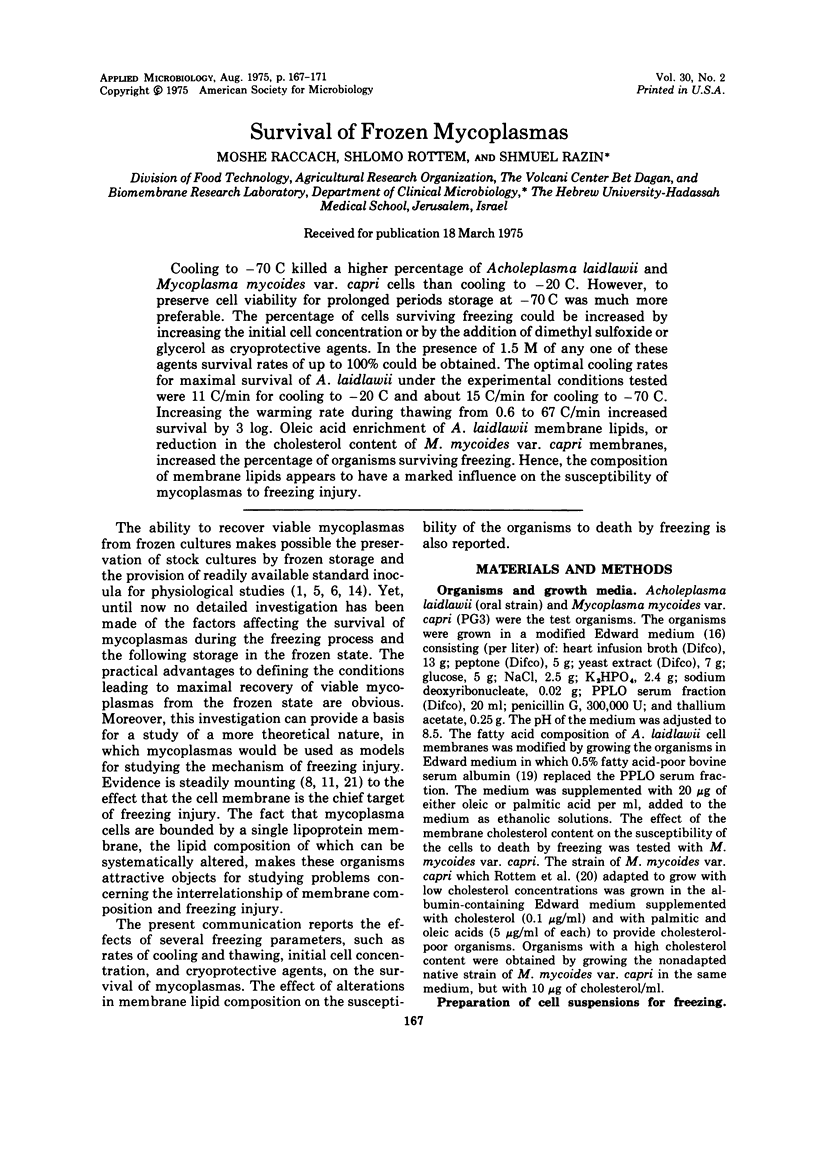
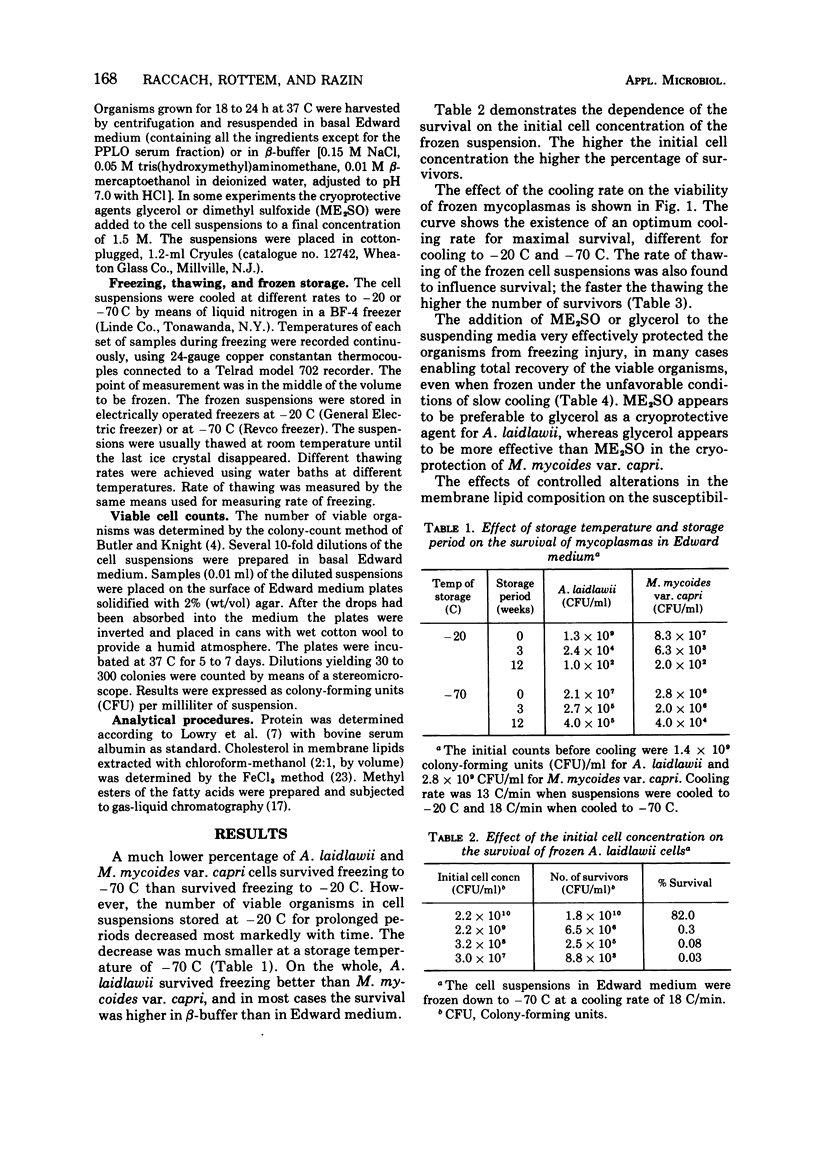
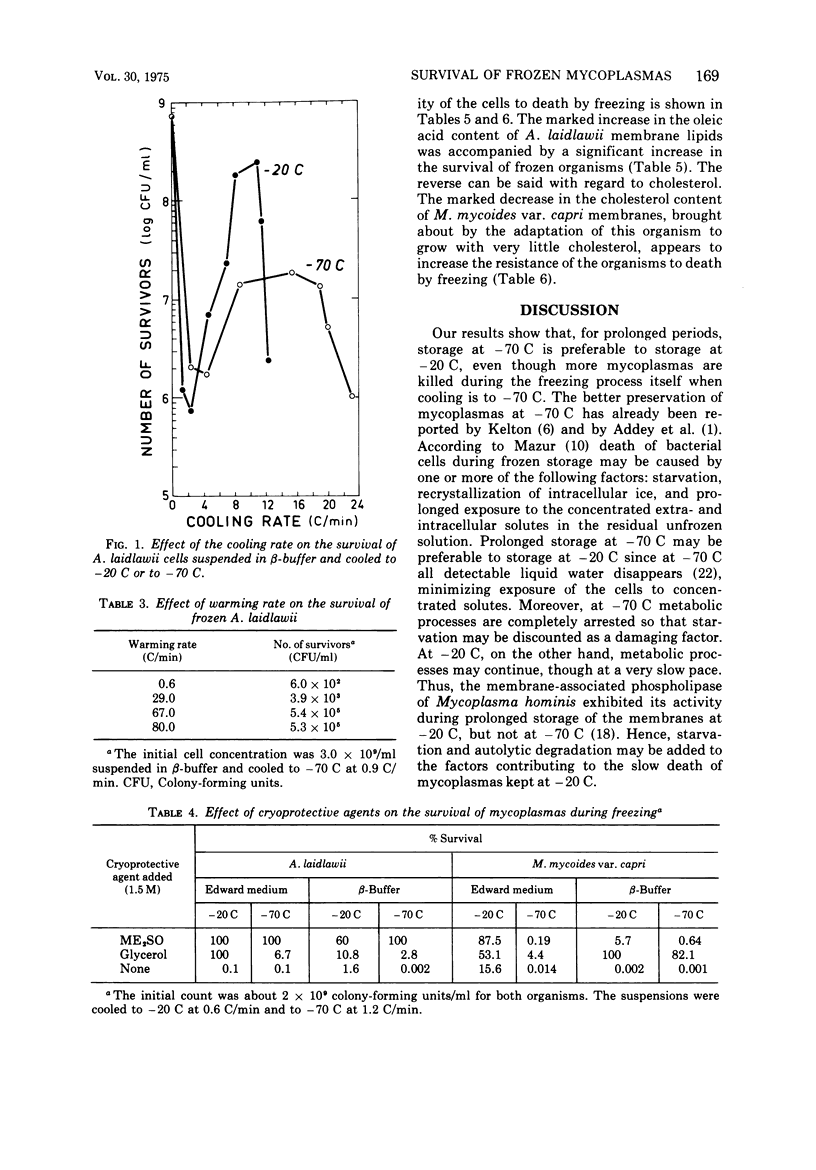
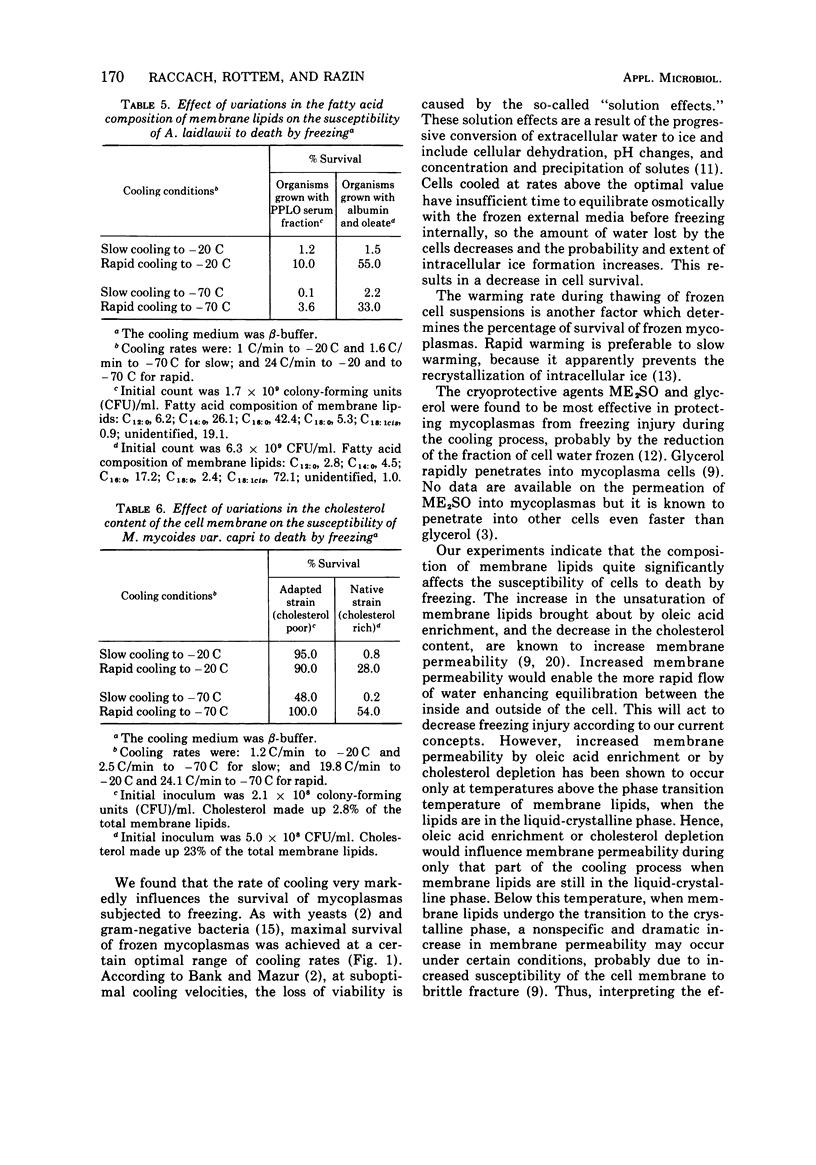
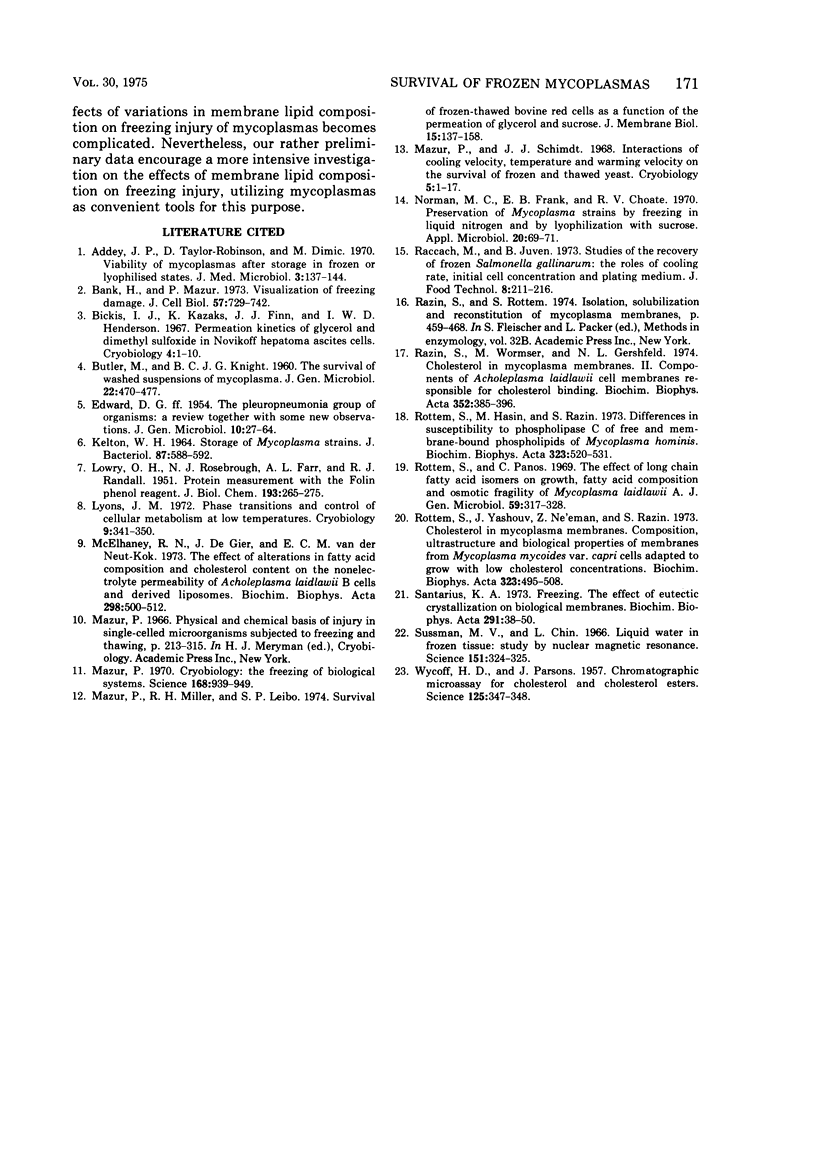
Selected References
These references are in PubMed. This may not be the complete list of references from this article.
- Addey J. P., Taylor-Robinson D., Dimic M. Viability of mycoplasmas after storage in frozen or lyophilised states. J Med Microbiol. 1970 Feb;3(1):137–145. doi: 10.1099/00222615-3-1-137. [DOI] [PubMed] [Google Scholar]
- BUTLER M., KNIGHT B. C. The survival of washed suspensions of Mycoplasma. J Gen Microbiol. 1960 Apr;22:470–477. doi: 10.1099/00221287-22-2-470. [DOI] [PubMed] [Google Scholar]
- Bank H., Mazur P. Visualization of freezing damage. J Cell Biol. 1973 Jun;57(3):729–742. doi: 10.1083/jcb.57.3.729. [DOI] [PMC free article] [PubMed] [Google Scholar]
- Bickis I. J., Kazaks K., Finn J. J., Henderson I. W. Permeation kinetics of glycerol and dimethyl sulfoxide in Novikoff hepatoma ascites cells. Cryobiology. 1967 Jul-Aug;4(1):1–10. doi: 10.1016/s0011-2240(67)80180-9. [DOI] [PubMed] [Google Scholar]
- EDWARD D. G. The pleuropneumonia group of organisms: a review, together with some new observations. J Gen Microbiol. 1954 Feb;10(1):27–64. doi: 10.1099/00221287-10-1-27. [DOI] [PubMed] [Google Scholar]
- KELTON W. H. STORAGE OF MYCOPLASMA STRAINS. J Bacteriol. 1964 Mar;87:588–592. doi: 10.1128/jb.87.3.588-592.1964. [DOI] [PMC free article] [PubMed] [Google Scholar]
- LOWRY O. H., ROSEBROUGH N. J., FARR A. L., RANDALL R. J. Protein measurement with the Folin phenol reagent. J Biol Chem. 1951 Nov;193(1):265–275. [PubMed] [Google Scholar]
- Lyons J. M. Phase transitions and control of cellular metabolism at low temperatures. Cryobiology. 1972 Oct;9(5):341–350. doi: 10.1016/0011-2240(72)90152-6. [DOI] [PubMed] [Google Scholar]
- Mazur P. Cryobiology: the freezing of biological systems. Science. 1970 May 22;168(3934):939–949. doi: 10.1126/science.168.3934.939. [DOI] [PubMed] [Google Scholar]
- Mazur P., Miller R. H., Leibo S. P. Survival of frozen-thawed bovine red cells as a function of the permeation of glycerol and sucrose. J Membr Biol. 1974;15(2):137–158. doi: 10.1007/BF01870085. [DOI] [PubMed] [Google Scholar]
- Mazur P., Schmidt J. J. Interactions of cooling velocity, temperature, and warming velocity on the survival of frozen and thawed yeast. Cryobiology. 1968 Jul-Aug;5(1):1–17. doi: 10.1016/s0011-2240(68)80138-5. [DOI] [PubMed] [Google Scholar]
- Mcelhaney R. N., de Gier J., van der Neut-Kok E. C. The effect of alterations in fatty acid composition and cholesterol content on the nonelectrolyte permeability of Acholeplasma laidlawii B cells and derived liposomes. Biochim Biophys Acta. 1973 Mar 16;298(2):500–512. doi: 10.1016/0005-2736(73)90376-3. [DOI] [PubMed] [Google Scholar]
- Norman M. C., Franck E. B., Choate R. V. Preservation of Mycoplasma strains by freezing in liquid nitrogen and by lyophilization with sucrose. Appl Microbiol. 1970 Jul;20(1):69–71. doi: 10.1128/am.20.1.69-71.1970. [DOI] [PMC free article] [PubMed] [Google Scholar]
- PARSONS J., WYCOFF H. D. Chromatographic microassay for cholesterol and cholesterol esters. Science. 1957 Feb 22;125(3243):347–348. doi: 10.1126/science.125.3243.347. [DOI] [PubMed] [Google Scholar]
- Razin S., Rottem S. Isolation, solubilization, and reconstitution of mycoplasma membranes. Methods Enzymol. 1974;32:459–468. doi: 10.1016/0076-6879(74)32045-9. [DOI] [PubMed] [Google Scholar]
- Razin S., Wormser M., Gershfeld N. L. Cholesterol in mycoplasma membranes. II. Components of Acholeplasma laidlawii cell membranes responsible for cholesterol binding. Biochim Biophys Acta. 1974 Jun 29;352(3):385–396. doi: 10.1016/0005-2736(74)90230-2. [DOI] [PubMed] [Google Scholar]
- Rottem S., Hasin M., Razin S. Differences in susceptibility to phospholipase C of free and membrane-bound phospholipids of Mycoplasma hominis. Biochim Biophys Acta. 1973 Nov 16;323(4):520–531. doi: 10.1016/0005-2736(73)90160-0. [DOI] [PubMed] [Google Scholar]
- Rottem S., Panos C. The effect of long chain fatty acid isomers on growth, fatty acid composition and osmotic fragility of Mycoplasma laidlawii A. J Gen Microbiol. 1969 Dec;59(3):317–328. doi: 10.1099/00221287-59-3-317. [DOI] [PubMed] [Google Scholar]
- Rottem S., Yashouv J., Ne'eman Z., Razin S. Cholesterol in mycoplasma membranes. Composition, ultrastructure and biological properties of membranes from Mycoplasma mycoides var. capri cells adapted to grow with low cholesterol concentrations. Biochim Biophys Acta. 1973 Nov 16;323(4):495–508. doi: 10.1016/0005-2736(73)90158-2. [DOI] [PubMed] [Google Scholar]
- Santarius K. A. Freezing. The effect of eutectic crystallization on biological membranes. Biochim Biophys Acta. 1973 Jan 2;291(1):38–50. doi: 10.1016/0005-2736(73)90058-8. [DOI] [PubMed] [Google Scholar]
- Sussman M. V., Chin L. Liquid water in frozen tissue: study by nuclear magnetic resonance. Science. 1966 Jan 21;151(3708):324–325. doi: 10.1126/science.151.3708.324. [DOI] [PubMed] [Google Scholar]


